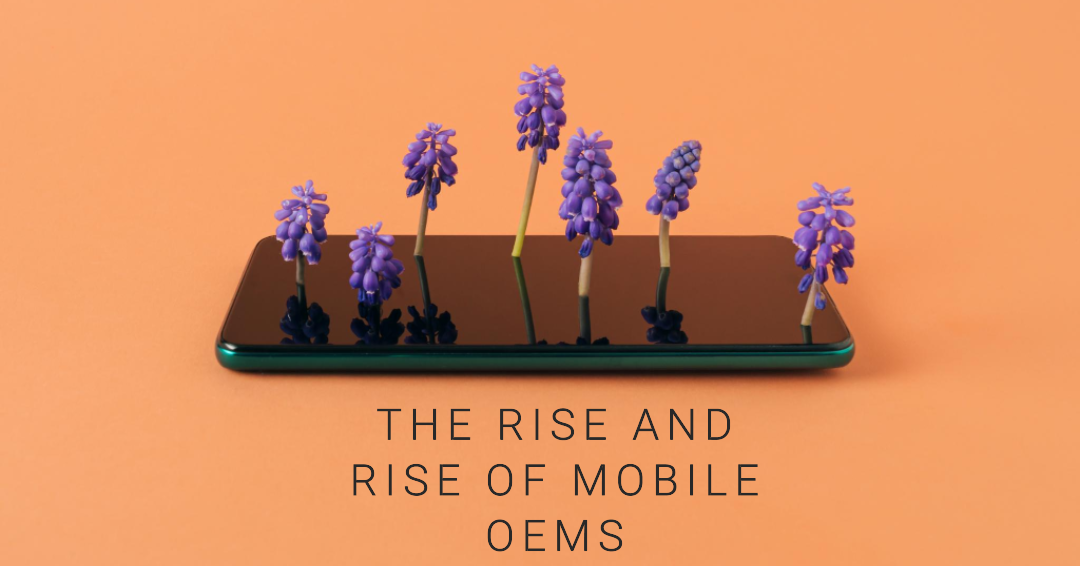Mobile OEMs Are On the Up
→ Learn everything about mobile OEM advertising and alternative app stores in our comprehensive guide.
The app market is changing. Or rather, it has already changed. What was once seen as a novelty for mobile phones has exploded into a multibillion-dollar industry. Where once Silicon Valley ruled, a host of challengers have entered the market to disrupt their dominance, opening up new horizons for phone users, app developers, and marketers alike. One group shaking things up is mobile OEMs, who have seen the value in the synergy between software, hardware and building an ecosystem for users and marketers alike.
Recognising this value, the mobile OEM industry has expanded rapidly over the last few years, with many mobile OEMs becoming the device of choice for consumers across APAC and Western markets alike. And when it comes to market share in Europe, mobile OEMs such as OPPO, Xiaomi and Huawei are occupying 3 of the top 5 places.
- In Spain, Xiaomi is the most popular smartphone brand, comprising over a quarter of the entire mobile market
- Xiaomi also takes top spot in India, the world’s second largest mobile market, with Vivo, OPPO and realme rounding out the country’s top 5 mobile OEMs
- In Indonesia, OPPO reigns supreme, comprising a fifth of the market, with Xiaomi and Vivo also present in the country’s top 4 mobile OEMs, constituting approximately 15% of the total market each.
As such, these figures shatter the misapprehension that, when it comes to their mobile market share, mobile OEMs are niche. On the contrary, as this data shows, they are in fact leading some of the world’s largest mobile markets.
All Eyes on Mobile OEMs
Despite this success, business doesn’t stop. At the moment Vivo, OPPO, and other mobile OEMs are investing heavily in branding, positioning themselves as premium offerings for both consumers and advertisers alike, while also penetrating new audiences via partnerships. Vivo, for instance, was one of the main sponsors of last year’s Fifa World Cup and the 2020 UEFA European Football Championship, while OPPO has sponsored the UEFA Champions League as well as the prestigious tennis tournaments Wimbledon and the French Open.
What’s more, Vivo and OPPO are also getting behind the stumps, becoming sponsors of this year’s ICC Cricket World Cup in India in addition to being the official partner for the Indian Premier League cricket championship, enhancing their reach. For these mobile OEMS, such gestures help foster a reputation among potential consumers both locally and internationally.
“Being a part of the most exhilarating sporting tournaments and competitions is very important to OPPO,” explained Elvis Zhou, OPPO’s overseas chief marketing officer, in a recent interview. “The international influence and local appeal of sporting events will not only help to enhance OPPO’s global brand influence but also help to create an emotional connection with local users.”
Elsewhere, OPPO is expanding its audience by sponsoring esports. In 2019, it became an official partner of online multiplayer video game League of Legends. As a result of supporting 2022’s fourth most popular game—one with 117 million monthly active users—OPPO has been able to capture the youth and gaming market, a segment usually out of bounds to traditional sponsorships. The mobile OEM market is understandably happy with this trajectory.
Proliferation of Mobile OEMs and Alternative App Stores
Another solid-gold sign that mobile OEMs aren’t just a flash in the pan is money. In 2021, the revenue accrued by alternative app stores totalled approximately $36 billion—nearly a quarter of the entire market—and today, their downloads outstrip those from Apple App Store three times over. Moreover, the user rates for alternative app stores are also impressive. Today, Huawei’s AppGallery boasts over 530 million monthly active users and receives 750 million downloads daily.
4 Main Benefits of Mobile OEM Advertising
Alternative app stores offer many benefits, but for marketers there are three perks that they should be aware of when considering mobile OEMs as part of their marketing mix.
They’re cost-effective yet premium: Mobile OEMs offer premium ad placements and formats directly on their devices without the high cost commonly associated with digital advertising. Dynamic Preloads, for instance, is one way that brands can reach new users without paying too much, since these offerings typically operate on a cost-per-install (CPI) model rather than the traditional cost-per-click (CPC) one
They offer an alternative to GAID and the Android Privacy Sandbox: Google has now followed in Apple’s footsteps, after Apple’s rollout of their App Tracking Transparency Framework (ATT) disrupted mobile advertising as we know it. Now Google will be rolling out its new Android Privacy Sandbox and kneecapping Google Advertising ID (GAID), disrupting mobile advertising even further. But fear not, as mobile OEMs now use an alternative known as the Open Anonymous Device Identifier (OAID). This allows mobile marketers to still track attributions and perform ad measurements, without the restrictions of the Android Privacy Sandbox and with user privacy still at the core of OAID.
They’re brand safe and fraud-free: With alternative app stores, your brand’s integrity is safe as all ads are shown in a secure and trusted environment. In addition, mobile OEMs guarantee that the traffic you receive is fraud-free. Consequently, the interactions and engagements that your ads generate are directly from the desired target audience, thereby avoiding intermediaries and/or dubious sources.
They offer enhanced targeting capabilities: Mobile OEMs also excel in their targeting capabilities, allowing advertisers to reach their desired audience effectively while respecting user privacy. Alternative app stores allow targeting of your desired audience through demographic data, geographic data, app usage, app behavior, and time spent on apps, among other metrics. This enables brands to zero-in on their target audience, increasing the chance of conversions and lowering the cost of acquisition.
Takeway: Mobile OEMs are Big, Bold, and Important for Success
As the adoption of mobile OEMs continues to grow, there has never been a better time to add alternative app stores to your marketing mix. From 2024, a new EU competition law will mandate Apple to allow alternative app stores on its iPhones and iPads. Elsewhere, similar developments with Android are afoot, where brand-new devices from mobile OEMs are now being shipped by default with the OEMs native app store. What’s more, tech innovators are continuing to challenge the market’s historically dominant entities, with Apple currently facing a $1 billion UK class action lawsuit filed by app developers over Apple Store fees. As such, alongside partnerships extending their audience range—as well as their booming user and download figures—mobile OEMs now have access to users they were once unable to reach. Marketers should therefore take note: it’s time to include alternative app stores in your strategies or risk missing out.
→ Learn everything about mobile OEM advertising and alternative app stores in our comprehensive guide.
About the Author






